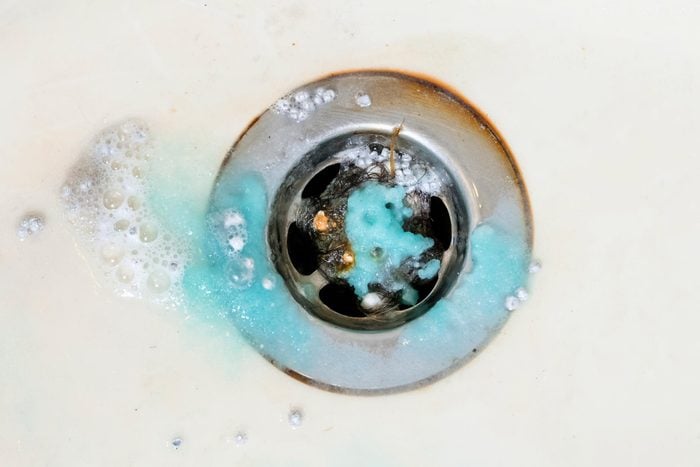How To Get Rid of Those Shower Drain Smells

Smelly shower drain? Get yours smelling fresh again with a few common household ingredients.
Our editors and experts handpick every product we feature. We may earn a commission from your purchases.
A hot shower invigorates first thing in the morning and soothes aching muscles after a long day. Whether you jump in for five minutes or linger under a luxurious spa shower, the last thing you want to deal with is a gross, smelly shower drain.
When I moved into my home, a weird smell greeted me that first day. Easy enough, I thought. I’ll clean the drain. Turns out the previous homeowner grouted the drain cover into the tile. So not only did I have to chip away all that grout, I had to do it while my face was a foot from someone else’s smelly shower runoff. Good times.
Joe Hammer, owner of the Phoenix-area SAK Electric & Plumbing, Inc., says cleaning your shower drain (if you can get the cover off!) is easy– you probably have the ingredients you need in your pantry already. Here he’ll explain what causes shower drain smells, how to clean a smelly drain and how to keep future odors at bay.
Here’s his pro insight and advice.
On This Page
Soap Scum
Soap scum forms when the molecules in soaps react with the ions in hard water, forming a precipitate. That white, filmy residue, combined with the dark, damp conditions of your drain, create a perfect breeding ground for bacteria and mold, Hammer says. Regular cleaning, he says, should minimize the buildup.
“At least once a month, remove the drain cover and scrub the drain with hot water, an all-purpose cleaner and a toothbrush,” Hammer says.
Next, clean out the pipes. Pour one cup of baking soda down the drain, then add one cup of distilled white vinegar. Wait at least 10 minutes. Then flush thoroughly with hot water.
In addition to regular cleaning, Hammer recommends using active bacteria sticks (aka enzyme sticks or just drain sticks) to keep soap scum and other residues from camping out in your drain. You can find these at most stores that sell appliances, or online. Just place a stick in your drain and the bacteria and enzymes eat away the buildup. That helps keep your pipes clear.
Dry P-trap
If you’ve walked into your bathroom and wondered, “Why does my bathroom smell like sewage?” you might have a dry P-trap.
P-traps, called that because they’re vaguely shaped like the letter P, hold a small amount of water in the drain pipe every time you use the sink or shower. That water acts as a physical barrier between the interior of your home and the sewer your drains empty into. (Toilets have their own integral P-traps, which do the same thing.)
Hammer says if your shower P-trap dries out, noxious sewer gases can migrate up the drain pipe and into your bathroom. Guest bathrooms that aren’t used a lot are particularly prone to dry P-traps. Run the shower periodically to refill the P-trap in little-used bathrooms, and clean as above for soap scum to keep your drain smelling fresh.
Mold
If mold is stinking up your shower drain, you might notice a musty odor. Molds love dark, moist environments, and your shower drain fits the bill. Molds need food, too. The soap scum, hair and shampoo concoction trapped down there looks pretty delicious to a mold colony.
To kill that mold, Hammer says to pour a solution of one-half cup bleach and two cups hot water down the drain. Let it sit for one hour, then rinse the drain well with hot water. A precaution: Never mix bleach with vinegar or other chemicals, because the combination can produce toxic gases.
Bacteria
Bacteria feeds on soap scum, hair, shampoo and other drain-dwelling substances. So-called “good bacteria,” like those in drain-cleaning enzyme sticks recommended above, eat away the gunk and send it down the drain. Other bacteria species, however, hang out on the slimy drain goo and release smelly substances into the air called microbial volatile organic compounds (mVOC).
To get rid of these odorous compounds, scrub the drain monthly with a toothbrush, all-purpose cleaner and hot water. Then give your pipes the vinegar and baking soda treatment. Finally, add a drain stick. This monthly combo will reduce biofilm buildup and prevent shower gunk-like soap and hair from accumulating.
Pro tip: Never use chemical drain cleaners like Drano on smells, clogs or anything else, Hammer says. The highly corrosive ingredients can damage your pipes, and those ingredients are caustic to your skin and eyes. Plus, they’re expensive.
If you have a large clog you can’t get rid of yourself, or if you can’t remedy the smelly drain, call a professional to check it out. You might have a bigger issue lurking.



